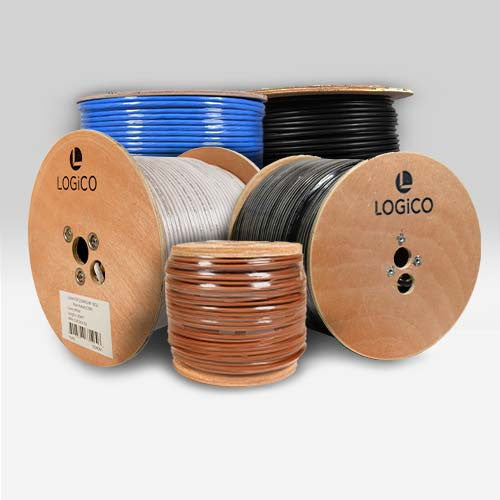You have no items in your shopping cart.
The Best Tips for Using Keystone Jacks and Couplers
In the actuality, where networking and telecommunications are soo common, the term "Keystone Jacks" holds significant importance. These small, rectangular modules are ubiquitous in the world of structured cabling systems. Their versatility and functionality make them indispensable components for creating reliable connections in various settings, from homes to commercial spaces. Understanding how to effectively utilize Keystones and their accompanying couplers can greatly enhance the efficiency and performance of your network infrastructure.
Understanding Keystone Jacks
This Keystone serve as modular connectors used in various networking applications. They are designed to snap into Keystone-compatible wall plates, patch panels, and surface-mount boxes, providing a standardized interface for connecting cables. The term "Keystone" derives from the shape of the jack, resembling the top of an old-fashioned arch or keystone.
Keystones are available in a variety of configurations to accommodate different types of cables, including Ethernet, coaxial, HDMI, and fiber optic. The most common type of Keystone is designed for Ethernet connections, supporting Cat5e, Cat6, and Cat6a cables. These jacks feature punch-down terminals or RJ45 connectors for terminating the cable conductors.
Types of Keystone Jacks
Ethernet Keystone Jacks: These jacks are specifically designed for Ethernet networking applications. They come in various categories, such as Cat5e, Cat6, and Cat6a, each offering different performance levels and bandwidth capabilities.
Coaxial Keystone Jacks: Used for connecting coaxial cables, these jacks are commonly employed in cable television, satellite TV, and broadband internet installations.
HDMI Keystone Jacks: Ideal for home theater and multimedia setups, HDMI Keystone Jacks facilitate high-definition audio and video connections between devices.
Fiber Optic Keystone Jacks: These jacks support fiber optic cables, enabling high-speed data transmission over long distances with minimal signal loss.
Best Tips for Max Potential
Here are some of the best tips for maximizing the potential of Keystone and couplers.
Choose the Right Type of Keystone Jack: When embarking on a cabling project, it's crucial to select the appropriate type of Keystone Jacks for your specific needs. There are various categories and types of Keystone Jacks available, such as Cat5e, Cat6, Cat6a, and beyond. Each category corresponds to different data transmission speeds and performance levels. Ensure that you choose Keystone Jacks that align with the requirements of your network infrastructure to achieve optimal results.
Pay Attention to Compatibility: Compatibility is key when it comes to Keystone Jacks and couplers. Before making any purchases, verify that the Keystone Jacks and couplers you intend to use are compatible with the rest of your networking equipment. This includes cables, patch panels, wall plates, and other components. Mixing incompatible components can lead to connectivity issues and hinder the overall performance of your network.
Proper Cable Termination: Achieving a reliable connection begins with proper cable termination. When terminating cables to Keystone Jacks, ensure that the wires are neatly arranged and securely fastened according to the designated wiring scheme, such as T568A or T568B. Proper cable termination not only ensures a stable connection but also facilitates troubleshooting and maintenance tasks in the future.
Use Keystone Jacks for Various Applications: Keystone Jacks are incredibly versatile and can be used for a wide range of applications beyond traditional Ethernet connections. They can accommodate various types of connectors, including RJ45 for Ethernet, RJ11 for telephone, RCA for audio/video, and F-type for coaxial connections. Leveraging the versatility of Keystones allows for streamlined installations and future-proofing of your infrastructure.
Invest in High-Quality Keystone Jacks and Couplers: Quality matters when it comes to Keystone Jacks and couplers. Investing in high-quality components may incur a slightly higher initial cost but pays off in terms of reliability, durability, and long-term performance. Opting for reputable brands and products known for their quality ensures that your network infrastructure operates smoothly and withstands the test of time.
Utilize Keystone Couplers for Flexibility: Keystone couplers offer flexibility in configuring and expanding your cabling setup. These simple yet effective devices allow for easy connection of two Keystone Jacks without the need for additional tools or complicated installations. Whether you need to extend cable runs or create custom patch panels, Keystone couplers provide a convenient solution that simplifies network management and organization.
Plan Your Keystone Jack Placement Strategically: Before installation, take the time to plan the placement of Keystone Jacks strategically. Consider factors such as cable routing, accessibility, and future expansion needs. By strategically placing Keystone Jacks, you can optimize cable management, minimize signal interference, and facilitate efficient troubleshooting and maintenance procedures down the line.
Label Keystone Jacks for Identification: Labeling Keystone Jacks can save you time and effort when troubleshooting or making changes to your network setup. Use clear and concise labels to identify each Keystone Jack according to its corresponding location, room, or device. This practice enhances organization and ensures that you can quickly identify and address any issues that may arise.
Maintain Proper Cable Management: Effective cable management is essential for maintaining a tidy and efficient network infrastructure. Properly organize and secure cables using cable ties, Velcro straps, or cable management panels. Keeping cables neat and orderly not only improves aesthetics but also reduces the risk of cable damage, signal interference, and accidental disconnections.
Regularly Inspect and Maintain Keystone Jacks: Routine inspection and maintenance are crucial for ensuring the continued performance and reliability of Keystone Jacks. Periodically check Keystone Jacks and couplers for signs of wear, damage, or corrosion. Clean connections and remove any debris that may impede signal transmission. By staying proactive with maintenance, you can mitigate potential issues before they escalate and optimize the lifespan of your network infrastructure.
Efficient Network Infrastructure
Keystone Jacks are soo important in the creation of robust and efficient network infrastructures. By following these tips and best practices, you can harness the full potential of Keystone Jacks and couplers to create reliable connections, streamline installations, and future-proof your network infrastructure for years to come. Whether you're a seasoned network technician or a DIY enthusiast, mastering the art of Keystone Jacks opens up a world of possibilities for building high-performance networks tailored to your specific needs and requirements.












